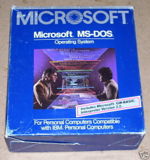MS-DOS
MS-DOS was made popular by Microsoft for not only being the bundled OS on the IBM-PC but also being available to the other clone OEM's of the time.
Microsoft had sold IBM on the idea of MS-DOS when talks for CP/M had broken down. At the time Microsoft had no such product but was able to secure the rights to "86-DOS" a CP/M clone written by Tim Paterson for the sum of $50,000. This has been the best ROI ever, as MS-DOS has made Microsoft untold billions of dollars.
MS-DOS uses the int21 interface to allow programs to communicate with MS-DOS. It is designed to be a single tasking OS, that runs on the 8088/8086 cpu, and on the real mode of the 80286 and higher CPU's. There are ways to crudely multitask via TSR's and other shells that hook the clock interrupt and jump execution although these are usually unstable at best.
DOS made use of the FAT filesystem, and thus its popularity.
Contents
Versions
MS-DOS 1.0
This was the first version to launch with the IBM 5150, or better known as the IBM PC. 1.0 'featured' a flat filesystem, and only supported the 5 1/4" diskettes.
MS-DOS 2.0
I think this release added support for the IBM XT and hard disks. Hierarchical filesystems were a new addition as well.
MS-DOS 3.0
I think this release added support for 5 1/4" high density disks, and the IBM AT.
MS-DOS 3.1
Did this version exist?
MS-DOS 3.2
Released April (or, according to some, August), 1986. This was the first OEM version of MS-DOS, a generic version for IBM-compatible PCs which for the first time included MS-written versions of the IBM utilities found in PC-DOS. Earlier versions of MS-DOS could not be considered complete, they only included the core parts (i.e. the MS-developed parts of PC-DOS), were licensed to non-IBM vendors, and had to be augmented with modifications as/if needed for the particular hardware and with vendor-written versions of utilities found in PC-DOS. Documentation also had to be provided by said vendors. MS-DOS version 3.2 changed all this, but the reason a generic MS-DOS could be produced was that vendors had started to see the point of being truly IBM compatible.
MS-DOS 3.3
I think this release added support for the 3 1/2" high density floppy.
I also recall this version being VERY popular... Even to the point where people avoided MS-DOS 4.00 to run this version.
MS-DOS 3.3 also included some support for the FAT16 filesystem, however its format command still was limited to FAT12 filesystems.
IBM (after a joint development agreement with Microsoft) was the main developer of MS-DOS 3.3, and PC-DOS 3.3 was nearly identical to the OEM version of MS-DOS 3.3
MS-DOS 4.0
This was the first release to support logical drives & extended partitions. This was also the first time that Microsoft had sold MS-DOS as a retail product, which was a break from the traditional OEM channels that Microsoft had fostered. I recall it selling for $50. DOS 4 still included the ancient programs edlin & gwbasic.
MS-DOS 4.0 could use partitions larger than 32MB. I've seen it on 512MB disks, it may go up to the full limitation of FAT16 of 2GB.
The first release 4.00 was VERY buggy, but I forget exactly why, although I recall something about 'large' 32MB files and various other things. Most people downgraded to 3.30. 4.01 addressed whatever issue it was, and it was good news.
Also making its apperance in MS-DOS 4.0 was the DOS shell, a simple GUI, to help people navigate their systems.
MS-DOS 4.0 was, as for version 3.3, mainly developed by IBM.
4.0 would have been released in 1988.
MS-DOS 5.0
This release was significant to allow for FAT partitions larger then 32MB, going up to 2GB. Also big features were himem.sys which allowed MS-DOS to execute in the top 64KB of protected mode because of a hardware bug in the IBM AT's handling of extended memory. Emm386.sys also was made popular allowing 386's to simulate EMS memory with extended memory, and loading device drivers & TSR's into the reserved hardware space.
Version 5.0 also brought Qbasic 1.0, to replace the aging GWBasic. Included were the example programs money, gorilla, nibbles & remline. Along with a proper editor based on the Qbasic interface, supplementing the ancient edlin.
DOS-5 also used an install program with the same look & feel from Windows 3.0.
There is also a horrible promotion video on youtube.
With version 5.0 Microsoft was again the main developer of MS-DOS.
MS-DOS 6.0
This release added disk compression in order to compete with Stacker. Also included were some simple tools licensed from Central Point, including an anti virus program MSAV, a graphical backup program MSBACKUP, a defrag program licensed from symantec.
MS-DOS 6.0 was mainly to compete with the feature full DR-DOS 6.0
MS-DOS 6.21
MS-DOS 6.22
This release was to rectify the various lawsuits around the bundled disk compression.
This was also the last retail version of MS-DOS. As version 7 of MS-DOS was the base part of Windows 95.



